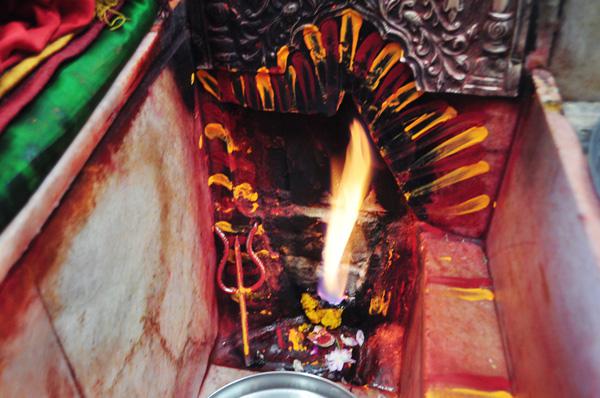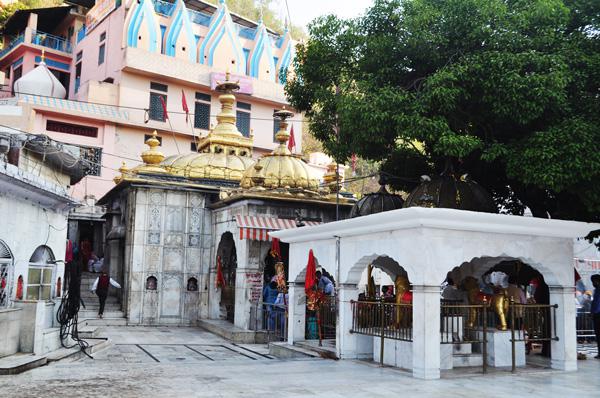

The temple of Shri Jwaladevi in Himachal Pradesh is one of the important temples in the country. It is one out of the 51 Shaktipeethas ! This temple is situated in the Kangda District in Himachal Pradesh. Unable to bear the humiliation of Her husband by King Daksha, Sati sacrificed Her body into the yadnya (fire sacrifice). This incident bereaved Deity Shiva so intensely that He began to wander with Her corpse on His back. Deity Vishnu with His sudarshan chakra (Divine discus) cut Sati’s body into 51 parts and wherever each part fell on the earth, became a Shaktipeeth. It was the tongue of Sati Devi that fell and thus this place too became a shaktipeeth .
The nine flames and Gorakh dibbi in the temple which left the scientists speechless !
Nine natural flames burn here eternally. The main flame is of Mahakali Devi. The remaining eight symbolise Annapurna, Chandi, Hingalaj, Vindhyavasini, Mahalakshmi, Saraswati, Ambika and Anjana Devis. In this temple the Divine Mother is worshipped in the form of flames, there are no idols. These flames burn continuously in the absence of oil or wicks of any kind. Despite the climate in Himachal Pradesh being very cold they never get extinguished. Till date even scientists have noit been explain this remarkable phenomenon.
Another wonder here is the water tank named ‘Gorakh dibbi’, adjoining the temple. When looked at the water in the tank it appears to be boiling but when touched it is cool.
Jwaladevi destroys the ego of Akbar !
This is the story when King Akbar, a Mughal ruled Bharat. The following incident occurred then. A devotee of Shri Jwaladevi, from Nadoun village was accompanying a thousand pilgrims to pay reverence to Her. Soldiers of Akbar restrained them on the way and took them to his court. Akbar made inquiries with the pilgrims. After hearing about the glory of the Devi from them he beheaded one of their horses and told the devotees ‘If Your devi is so powerful then let Her join the horse’s head back to its body’. Since the devotees had immense faith in the Devi they prayed to Her with surrender bhav, and attached the head to the trunk of the horse, bringing it back to life. Thereafter when Akbar visited the temple he was amazed by the naturally burning flames. He tried his level best using water, metal sheets etc to extinguish the flames, to no avail. Then he directed a stream of river Yamuna towards the temple, yet the flames remained unextinguished. At that juncture he realised his mistake and covered the temple with a gold roof. When he offered it to the Devi the thought in his mind was, ‘I am giving the Devi this gold roof’ The roof immediately collapsed. The Devi with Her energy converted that gold into a unique metal which is neither copper, brass or iron. Till today no one has been able to determine which metal this is.
Reference : Website of Aajtak and jawalaji.in
Characteristics of worship of certain Devis
1. Kumari (The virgin Deity)
Flowers and its garlands, grass, leaves, bark of trees, strands of cotton, turmeric, shendur (saffron powder used in worship), kunku (vermilion) etc. play an important role in Her worship. These Devis are offered objects which are dear to little girls.
2. Renuka, Ambabai and Tuljabhavani Devis
After some religious rite in the family such as a marriage those who have Her as their Kuladevata (Family Deity) perform a special dance called the ‘Gondhal’. This is akin to performing a Satyanarayan puja (ritualistic worship) or Bodan bharne (ritual of at least five married women and a virgin girl mixing together curd, milk, fried puri, boiled rice, honey, chapati etc and offering it as oblation to the Devi) in the Kokanastha Brahman community, as thanksgiving for successful completion of a religious rite such as a marriage in the family.
3. Ambaji
In the temple of Ambaji (Ambamata) in Gujarat instead of oil ghee is used for lighting the lamp continuously.
4.Tripursundari
‘This is one of the Devis of the Tantra branch of Spirituality and a sect of Her Name is prevalent. That sect believes that this Devi can be worshipped only after receiving initiation (diksha) from this sect.
5. Tripurbhairavi
She is a Devi of the Tantra branch of Spirituality. It is believed that She is a Devi ‘who helps in accomplishing the three pursuits of life (purusharthas) – Dharma (Righteouness), artha (wealth) and kama (fulfillment of desires)’. She has erupted from a Shivalinga. She has been described in the Kalikapuran. Of all Her forms the Bhairavi form is considered the most powerful. She is worshipped with the left hand. Red madira (liquor), red flowers, red clothes and shendur are dear to Her.’
6. Mahishasuramardini
If incapable of tolerating the energy of the Devi then first Shantadurga Devi, then Durga Devi and finally Mahishasuramardini are invoked. This increases the ability to endure the energy of the Devi stepwise, so finally the energy of Mahishasuramardini becomes tolerable.
7. Kali
‘Worship of Kali Devi is prevalent in Bangladesh since times immemorial. The two Holy texts ‘Shyamarahasya’ and ‘Tantrasar’ by Purnanand and Krushnanand respectively, are famous. In this worship sura (liquor) is an extremely important constituent. It is partaken of after purification with mantras (a syllable, word or words representing spiritual reality or an aspect of God uttered to protect oneself or to achieve a specific goal). The Kaliyantra (spiritual device) used in worship of Kali has to be either triangular, pentagonal or nonagonal according to the Kalikopanishad. At times it has 15 facets. To be able to derive maximum benefit Kali puja is performed in the Krushna paksha (dark fortnight) of the Hindu lunar month of Kartik, especially at night. This puja includes recitation of the Kalistotra (Holy verse in praise of the Devi), kavach (protective armour) and Her hundred Names (shatanam) and thousand Names (sahastranam).’
8. Chamunda
Eight hidden Yoginis (female attendants) function under the control of the main Devi, controlling the universe, creating things, bringing about effects etc. A special puja called ‘Sandhipuja’ is performed on the Hindu lunar dates (tithis) of ashtami (eight day) and navami (ninth day) at twilight (sandhikal is the transitional period between day and night), for the Chamunda form of Durga Devi. Devotees remain awake all night amidst singing, playing of musical instruments and playing.
9. Durga
The Shri Durgamahayantra is the seat (asan) of Shri Bhagwatidevi (Durga). During Navaratri all the nine forms of Devi Durga are worshipped.
10. Uttanpada
This Devi is enriched with the three virtues of motherhood, reproduction and creation of the universe. Since the olden days the tradition of worshipping the idols of Chinnamasta or Lajjagauri Devis by placing them on the ground, in the prone position (back touching the ground) with Her folded legs facing the worshipper, is prevalent. She is worshipped in the same way as the shalunka (stone in the form of and symbolising the birth passage) present in the lower part of the Shivapindi. After She is consecrated (abhishek) with a stream of water it flows along a route kept for that purpose. This pathway of the Shivapindi is referred to as ‘the great path (mahamarg) of the great birth passage (mahabhag) of Supreme Shiva (Mahashiva)’.
Reference : Sanatan’s Holy text ‘Divine Energy (Shakti) Part 2’
Comparison with other Paths of Yoga (union with God)
The Path of Knowledge which makes you expansive
universally and the Path of Divine Energy which makes you subtlemost
By following the Path of Knowledge you become universally expansive, that is experience how the Sattva form exists in everything – water, wood, marble etc. Through the Path of Divine Energy you can become as tiny as an atom and win Hari over with intense humility (realising that knowledge is infinite if a follower of the Path of Knowledge becomes expansive, and instead of manifesting the energy if a follower of Divine Energy becomes more humble then they both make spiritual progress along their respective paths).
‘The spirit which became humble, silenced God – Saint Tukaram Maharaj’

 Devotees faith in their wishes getting fulfilled if the idol in the Bhaleyi Mata temple...
Devotees faith in their wishes getting fulfilled if the idol in the Bhaleyi Mata temple... Shri Kamakhya devi who got Narakasura annihilated from Shrivishnu through Her Yogamaya, and Kamakhya temple...
Shri Kamakhya devi who got Narakasura annihilated from Shrivishnu through Her Yogamaya, and Kamakhya temple... Darshan taken by Shrichitshakti (Mrs.) Anjali Gadgil of Shri Chandi-Chamunda Devi, the form of Adishakti,...
Darshan taken by Shrichitshakti (Mrs.) Anjali Gadgil of Shri Chandi-Chamunda Devi, the form of Adishakti,... Shrichitshakti (Mrs.) Anjali Gadgil’s visit to ‘Manikarna Taptakunda’ (Dist. Kullu) that was created with the...
Shrichitshakti (Mrs.) Anjali Gadgil’s visit to ‘Manikarna Taptakunda’ (Dist. Kullu) that was created with the... Shri Vaishnodevi from Katra (Jammu), a place of worship for millions of devotees from all...
Shri Vaishnodevi from Katra (Jammu), a place of worship for millions of devotees from all... Shri Tripurasundari Devi gives vision to King Dhanyamanik in his dreams, and attains the seat...
Shri Tripurasundari Devi gives vision to King Dhanyamanik in his dreams, and attains the seat...